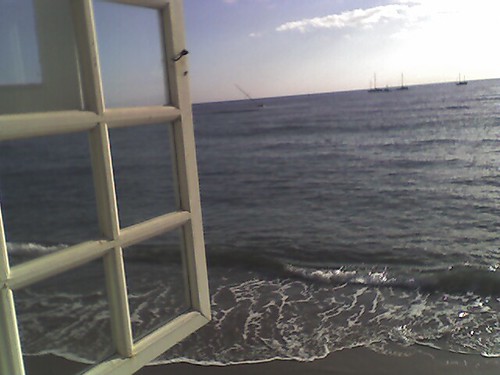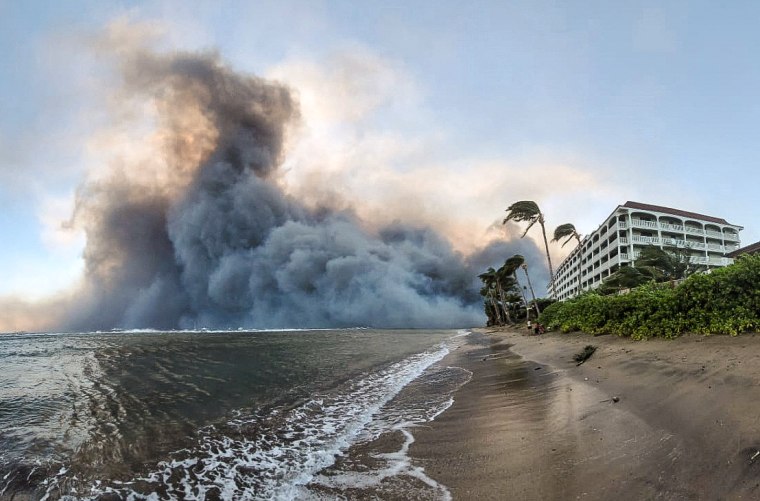Wildfire decimates Lahaina, once the capital of the Hawaiian Kingdom
Lahaina #Lahaina

A historic seaside town that once was the capital of the Kingdom of Hawaii has been largely reduced to ash as wildfires continued to rip through the state Wednesday.
The town of Lahaina, situated on the west coast of Maui, was evacuated along with several others on both Maui and the Big Island. Video obtained by NBC News shows the town in chaos, with local businesses ablaze and heavy smoke filling the streets. Some residents jumped into the ocean seeking safety from the flames.
According to official updates on the town’s website, “Hundreds of families have been displaced, dozens of businesses have burned, and there’s a strong chance some people have died.” Officials confirmed Thursday that at least 36 people have died.
Follow live coverage of the Maui wildfires
Hawaiians say Lahaina’s disaster leaves them mourning the loss of a place dense with Native Hawaiian history and culture — and they’re bracing for what the tragedy will mean for their communities in the long term.
“People are worried about their loved ones, their homes, their businesses, their jobs,” said David Aiona Chang, who is Native Hawaiian and a professor of history at the University of Minnesota. “So many of the disasters that hit Hawaii hit Native Hawaiians the hardest. It’s something that we are going to be dealing with for a long time.”
Many visitors know Lahaina as a popular vacation destination, but Kaniela Ing, who grew up in the area and co-founded the Native Hawaiian-focused organization Our Hawaii, underscored that the town’s significance long predates Western interest.
He said the fire is a “scorching warning” of what’s to come if indigenous communities aren’t protected from the impacts of climate change.
“Our home is on fire right now. There needs to be more action and more investment,” said Ing, who’s seventh-generation Kānaka Maoli, or indigenous Hawaiian. “People hit first and worse by the climate crisis tend to be Black, indigenous and low income. Yet we’re the keepers of the knowledge of how to build a society that wouldn’t cause ecological collapse and societal doom.”
A town rich with Hawaiian history
A stroll through Lahaina town 48 hours ago would have given you a glimpse into the rich past of the island, Ing said.
“If you start from one end of Front Street and walk to the other end, it’s like a physical timeline of the history of the Hawaiian Kingdom,” Ing said. “You can actually see the flow in the buildings stemming back 150 or more years. It’s remarkable and just the thought that that history may have been lost in this fire or any bit of that history is heartbreaking.”
Lahaina’s story, experts say, began centuries ago.
Even before the formation of the Kingdom of Hawaii in 1795, Lahaina was an important place where chiefs from different parts of Maui would gather, said Chang. But in 1802, after King Kamehameha had conquered several islands on the archipelago, Lahaina was made the Hawaiian Kingdom’s official capital.
In addition to being the political center of Hawaii, it became a whaling and fishing bastion throughout the 1800s. The economic boom made Lahaina a global trade hub that connected Hawaii to the rest of the world.
Honolulu became the state’s capital in 1845 and, in the decades that followed, the United States began its effort to claim Hawaii. Americans usurped the kingdom’s government and denied suffrage to Native Hawaiians in 1887. An American coup overthrew the queen in 1893 and the U.S. annexed it as a territory in 1898.
“Not all history is positive, not all nostalgia is good memories, but you still should preserve it,” Ing said.
The story of Lahaina is one of resistance, Ing said. While many attempts were made to develop Front Street in the heart of the town, protests and pushback curbed the process, he explained.
“When the whaling industry got established and they pushed out subsistence fishing, there were protests on construction pretty much every step of the way,” Ing said. “Our ancestors, especially Native Hawaiians fought them every step of the way. Front Street is also a reminder of that history of resistance.”
 Smoke billows as wildfires destroy a large part of the Lahaina, HI, on Wednesday.Dustin Johnson via ReutersHawaiians left to contend with the destruction
Smoke billows as wildfires destroy a large part of the Lahaina, HI, on Wednesday.Dustin Johnson via ReutersHawaiians left to contend with the destruction
A large banyan tree in Old Lahaina marked the place where King Kamehameha’s first palace stood. Much of that tree has now been burned in the fires, according to the town’s website.
John-Mario Sevilla, 60, grew up in Maui and would often visit Lahaina with his family. He remembers sitting in church there as the ocean breeze blew in the open windows, and watching the traditional dancing under the banyan tree.
He acknowledged the fire has likely wiped out many of the places he remembers.
“It’s a tragic loss for everyone who lives there and for the whole island,” he said. “The whole island will be impacted by it.”
As residents begin to process the damage and destruction caused by the fires, Ing said it’s critical to consider indigenous communities when making decisions about next steps for the community.
“When native folks are resourced to do this kind of work, it’s generally to stop the bad and not necessarily build the good,” Ing said. “There needs to be a lot of intention and hard intervention there to make sure that federal resources and philosophical resources go to support native folks, not to stop acute harm like this, but actually, lead us on the positive path forward.”